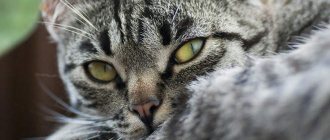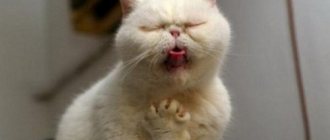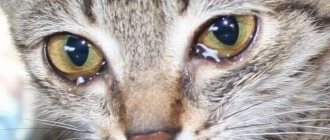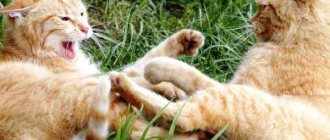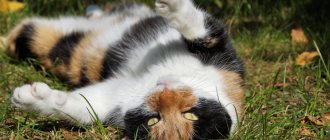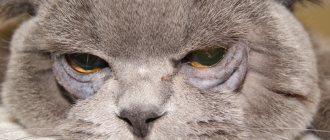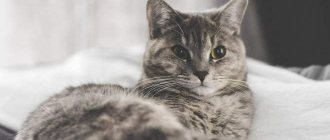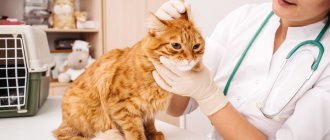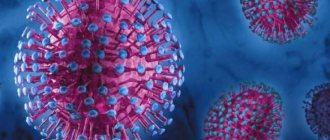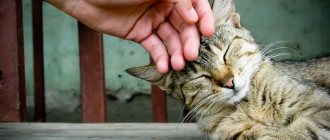A disease such as volvulus in cats is quite difficult for pets to tolerate. It negatively affects the functioning of the gastrointestinal tract and causes necrosis of the intestinal walls. At the first symptoms, the owner should seek help from a clinic. There, the cat will undergo a thorough diagnosis to rule out other possible diseases and will be sent for surgery. Lack of timely treatment leads to death.
Causes of appearance: what is the provocateur?
According to veterinary statistics, kittens up to one year old are susceptible to the disease, but it also occurs in adults.
Volvulus usually occurs in animals with increased intra-abdominal pressure. This disorder occurs in cats that are exposed to excessive physical activity (running, jumping) immediately after eating. There should be a break between eating and activity. Another common cause is poor diet, which causes intestinal obstruction. If a long period of hunger is replaced by overeating, then gastric volvulus develops. The disease occurs when foreign bodies get inside the cat, often small bones from fish or meat.
Pathology can develop against the background of a hernia in a pet.
Other causes of volvulus:
- constipation;
- intestinal paresis;
- oncological diseases of the gastrointestinal tract;
- hernias
Which breeds are more susceptible
Ileus can occur in any cat, regardless of age or gender. Representatives of long-haired breeds, for example, Persians, Siberians, Maine Coons, are most susceptible to this phenomenon. Numerous hair that enters the stomach during licking forms trichobezoars - dense hairballs. They are the most common cause of intestinal obstruction.
Symptoms of the disease
The most obvious sign of volvulus is cramps in the stomach. In this case, the cat behaves restlessly, tries to lie down and curl up. Due to the accumulation of gases in the abdominal cavity, the pet may begin to rock on the floor. On palpation, the stomach feels swollen. After eating, kittens begin to vomit. Because of this, dehydration of the body develops. The kitten becomes constipated and loses weight. Oxygen does not reach the intestines, causing the cat to go into hypovolemic shock. The pet is depressed, his temperature rises, and fainting may occur. On examination, blanching of the mucous membrane is observed.
Possible complications
You need to understand that ileus is a very dangerous condition. If left untreated, intestinal obstruction leads to disastrous consequences, including death. Feces, gases, and gastric juices accumulate in the intestines, as a result of which the blood supply is disrupted and necrosis (death of the intestinal walls) develops.
In addition, the body receives severe poisoning from decay products. This leads to the death of intestinal microflora and the development of putrefactive processes in the intestines.
The situation with partial ileus is somewhat simpler, when the intestinal lumen does not close completely, allowing gases and a small amount of feces to escape. However, this does not mean that treatment is not required.
Diagnosis of the disorder
The doctor can clarify the diagnosis of the animal during an ultrasound scan.
The main method of examination for this disease is radiography. This method helps determine the stage of development of the disease and assess which areas are affected in the intestine. For a more accurate diagnosis, it is necessary to do an ultrasound examination of the abdominal cavity. The veterinarian also prescribes a biochemical analysis of the animal's vomit, semen and blood. Using such research methods, the doctor can exclude diseases with similar symptoms.
Intestinal obstruction
- this is a complete or partial cessation of the movement of contents through the intestines. The most common cause is foreign body blockage. This is followed by blockage as a result of a tumor, volvulus, hernia or intussusception (penetration of one part of the intestine into another), etc.
Mechanical blockage with a foreign body reveals itself suddenly, out of the blue. How this happened a few days ago with my cat Avatar. Who is the cat Avatar and what is special about him - see here, it will be interesting.
Avatar During the day, vomiting suddenly began. At first I didn’t attach any importance to this. Well, I vomited once, who doesn’t? Again. Already alarmed. And I got really worried when the cat flatly refused to eat, without even looking towards the bowl. To test, she offered an impossible delicacy - a piece of chicken. Decisive refusal. Everything is bad!
Vomiting continued at night. And the next morning we were already at the clinic. They immediately took blood for analysis and put me on a drip without talking. Why?
Providing first aid and therapy
At the first sign of a violation, the owner should contact a veterinary clinic. Attempts at self-medication will only worsen the problem. If you try to force feed your pet when it doesn't want to, it will only harm the animal. It is also not recommended to give your cat antiemetics. It is better, if possible, to give an anesthetic injection to relieve pain. The further treatment regimen is prescribed only by a professional doctor.
Treatment of bloat
Surgery for illness
If the diagnosis is confirmed, the animal is indicated for emergency laparotomy surgery.
Having noticed the first signs of volvulus, the owner should urgently contact a veterinarian. After diagnosis, laparotomy is urgently prescribed. First, the surgeon straightens the twisted intestine. Afterwards, he examines all segments of the organ, finds necrotic tissue and removes them. Finally, an ileostomy is performed: the small intestine is diverted to the abdominal cavity to drain the pus. But intestinal adhesions are done only if there is peritonitis. If help is not provided in time, the cat may become disabled.
Care and recovery
After surgery, some of your cat's intestinal functions may not work, so it is important to carefully monitor your pet's health and care for it. After surgery, the cat is left in the clinic for several days for additional examination. The pet undergoes rehabilitation at home within a month. The veterinarian prescribes antibiotics to prevent inflammation.
If the animal is severely bothered by spasms, then it may be prescribed Baralgin.
Treatment is carried out with the help of medications. To relieve spasms, Baralgin is prescribed. It is important to restore the intestinal microflora after an illness, so the cat is given probiotics (“Lactobifid”). After dehydration, infusion of saline solutions is required. The pet owner needs to monitor the cat’s diet: the food should be light so as not to overstrain the stomach. In addition, it is necessary to take care of the stitches by treating them to prevent infection.
Diet
First, after surgery, complete fasting is established for 24 hours, with intravenous glucose. Sometimes, with extensive intestinal removal, parenteral feeding is required for several days.
The cat is then placed on a nasogastric tube or latex tube, which feeds food directly into the stomach.
Afterwards, liquid food should be introduced - vegetable purees and cereals with water, then meat purees and dairy products are gradually introduced. Then you can switch to soft food; in the first months after surgery, the cat can be fed baby food.
Feed should be fractional, in small portions, gradually increasing the amount of food per day to the normal weight.
The main problem after surgery is “short” bowel syndrome; the absorption surface decreases, which causes diarrhea and malabsorption syndrome.
Drug therapy
Infusion therapy must be prescribed to relieve the state of shock and normalize the water-salt balance. Usually saline solutions, Ringer-Locke solution, etc. are used.
A course of antibiotics is used to prevent postoperative complications and prevent the development of an infectious process. It is also necessary to prescribe prednisone, it provides relief from shock and prevents the development of adhesions.
For pain relief use baralgin or dalargin.
Enzyme support should be prescribed - Essentiale, Panzinorm.
Intramuscular administration of vitamin B12 is used as rehabilitation.
Prevention and prognosis
Only cats that are immediately diagnosed have a positive chance of survival. If help was provided late, there is a high risk of disability or death (40% of cases). But the best way to avoid pathology is prevention. To do this, it is recommended to feed your pet several times a day in small portions. It is advisable to include high-quality food in the diet that is easily absorbed by the body. Since your cat drinks a lot during the day, she should always have access to fresh water. Immediately after eating, the kitten needs a rest break. Be sure to protect the animal from stress. If symptoms of volvulus appear, you should immediately consult a doctor.
Treatment
Intestinal volvulus is a problem that can be solved, in most cases, surgically. And the sooner the operation is performed, the higher the chances of recovery. After diagnosing the exact location of the bloat, the veterinarian chooses a method of elimination. If necrosis has affected a minimum of intestinal tissue, the doctor cuts out the affected area and places the twisted section in the correct anatomical position. In the simplest cases, the veterinarian just needs to position the intestines correctly, removing any knots that have appeared.
© shutterstock
Depending on the complexity of the injuries caused, it depends on how difficult the operation will be, as well as the postoperative recovery period.
About Vaseline oil
Vaseline oil is a purified fraction of petroleum without harmful organic substances and their compounds, mixes with fats and oils and has the properties of petroleum jelly. Without being absorbed into the walls of the gastrointestinal tract, it envelops the obstacle in the form of feces, softens them and facilitates the process of pushing. Indication: constipation. Contraindication: intestinal obstruction.
Here we come to a difficult dilemma: constipation or obstruction? With constipation, accumulation and hardening of stool usually occurs in the middle and lower intestines. And Vaseline oil is your first friend here. It can also help with partial obstruction.
In case of complete obstruction, the oil will aggravate the situation, becoming an additional burden in the gastrointestinal tract. In addition, it can “drag through” a foreign object a little, damaging the intestinal walls and causing their necrosis.
Thus, giving a cat Vaseline oil when there is a blockage is a risk: it may solve the problem, or it may worsen the situation.
Partial obstruction
With incomplete obstruction, part of the intestinal contents can pass through the obstruction, but with complete obstruction, not. With partial blockage, the animal can survive, while complete blockage poses a mortal danger.
Avatar Two years ago, with the same Avatar (oh, poor cat!) we experienced partial obstruction. Avatar opened the cabinet under the kitchen sink and gutted the trash can. For more than two weeks (!) the cat was lethargic, ate a little and only soft food, there was stool, but very scanty. An X-ray with contrast did not give an accurate result (50x50 - it seems like there is an obstacle, but the contrast agent seems to pass through it). I was given intravenous drips every day. The doctors were inclined to operate.
Deciding that there was nothing to lose anyway, I literally pumped the cat up with Vaseline oil (I had done this before, but not so decisively - there was no result). And Avatar finally produced such a bunch of sausage skins that it was impossible to imagine how it all fit in a small intestine, lay there for two weeks, and the cat lived with it! But imagine my amazement when the next day another similar pile came out. Just unbelieveble! Since then, we have kept the trash can under safe lock and key.
